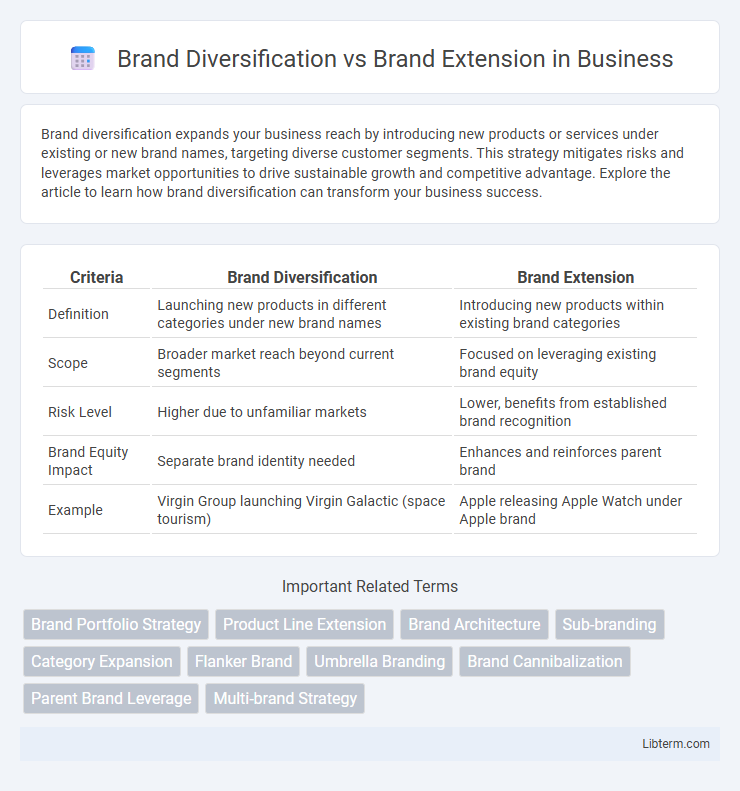Brand diversification expands your business reach by introducing new products or services under existing or new brand names, targeting diverse customer segments. This strategy mitigates risks and leverages market opportunities to drive sustainable growth and competitive advantage. Explore the article to learn how brand diversification can transform your business success.
Table of Comparison
| Criteria | Brand Diversification | Brand Extension |
|---|---|---|
| Definition | Launching new products in different categories under new brand names | Introducing new products within existing brand categories |
| Scope | Broader market reach beyond current segments | Focused on leveraging existing brand equity |
| Risk Level | Higher due to unfamiliar markets | Lower, benefits from established brand recognition |
| Brand Equity Impact | Separate brand identity needed | Enhances and reinforces parent brand |
| Example | Virgin Group launching Virgin Galactic (space tourism) | Apple releasing Apple Watch under Apple brand |
Introduction to Brand Diversification and Brand Extension
Brand diversification involves creating new brands to enter different markets, aiming to reduce risk by spreading business interests across varied product categories. Brand extension leverages an existing brand name to launch new products within the same market, capitalizing on established brand equity and customer loyalty. Both strategies are critical for growth but differ in risk levels, resource allocation, and market approach.
Defining Brand Diversification
Brand diversification involves creating entirely new product lines or entering different markets under a separate brand identity, allowing companies to reduce risk and tap into different consumer segments. Unlike brand extension, which leverages an existing brand name to introduce new products, brand diversification establishes distinct brands that operate independently. This strategy enhances market reach by targeting diverse customer needs without diluting the core brand equity.
Understanding Brand Extension
Brand extension involves leveraging an established brand name to launch new products within the same or related categories, capitalizing on existing brand equity to reduce marketing costs and increase consumer acceptance. It strengthens brand recognition by maintaining consistent brand attributes while meeting diverse customer needs through product variety. Successful brand extension requires strategic alignment with core brand values to avoid brand dilution and sustain competitive advantage in target markets.
Key Differences Between Brand Diversification and Brand Extension
Brand diversification involves launching new products in entirely different markets or industries, enabling companies to spread risk and capture new customer segments. Brand extension focuses on leveraging an existing brand name to introduce new products within the same or closely related categories, enhancing brand equity and consumer trust. The key difference lies in diversification targeting unrelated markets, while extension stays within the brand's core market domain.
Benefits of Brand Diversification
Brand diversification enables companies to enter new markets and reduce risks by spreading investments across different product lines, enhancing overall business stability. It fosters innovation by encouraging exploration of diverse customer needs, leading to unique product offerings that boost competitive advantage. Expanding brand identity through diversification also improves market presence and customer loyalty by catering to a broader audience.
Advantages of Brand Extension
Brand extension leverages an existing brand's strong equity and customer loyalty, reducing the cost and risk associated with launching new products. It enables faster market acceptance and enhances brand visibility across different product categories, leading to increased revenue streams. By capitalizing on familiar brand attributes, companies can efficiently enter new markets and strengthen overall brand positioning.
Risks and Challenges of Each Strategy
Brand diversification involves launching new products in unrelated markets, posing risks such as resource dilution, brand identity confusion, and operational complexities. Brand extension carries challenges like customer resistance, potential damage to the parent brand's reputation, and the risk of cannibalizing existing product sales. Both strategies require careful market analysis and strategic alignment to mitigate financial losses and maintain brand equity.
Notable Examples of Brand Diversification
Notable examples of brand diversification include Virgin Group, which expanded from music and airlines into telecommunications, healthcare, and space travel, illustrating a strategic move beyond its core industries. Samsung demonstrates brand diversification by operating across various sectors such as electronics, construction, and shipbuilding, leveraging its brand equity in multiple markets. Tata Group showcases broad diversification with ventures spanning from automotive to steel, hospitality, and information technology, highlighting the power of leveraging a strong corporate brand across diverse industries.
Successful Brand Extension Case Studies
Successful brand extension case studies highlight how companies like Apple and Virgin have leveraged their strong brand equity to enter new markets effectively. Apple's expansion from computers to smartphones and wearables maintained consistent quality and innovation, boosting consumer trust and sales. Virgin's venture into airlines and telecommunications capitalized on its adventurous brand personality, creating distinct yet connected brand experiences.
Choosing the Right Brand Growth Strategy
Choosing the right brand growth strategy involves evaluating the core competencies and market positioning of the existing brand to determine whether brand diversification or brand extension will maximize value. Brand extension leverages existing brand equity by entering related product categories, reducing risk and increasing consumer trust, while brand diversification targets new markets with distinct products, offering higher growth potential but requiring substantial investment and market research. Effective decision-making depends on aligning growth strategies with customer needs, competitive landscape, and long-term brand vision to ensure sustainable expansion and brand equity preservation.
Brand Diversification Infographic

 libterm.com
libterm.com